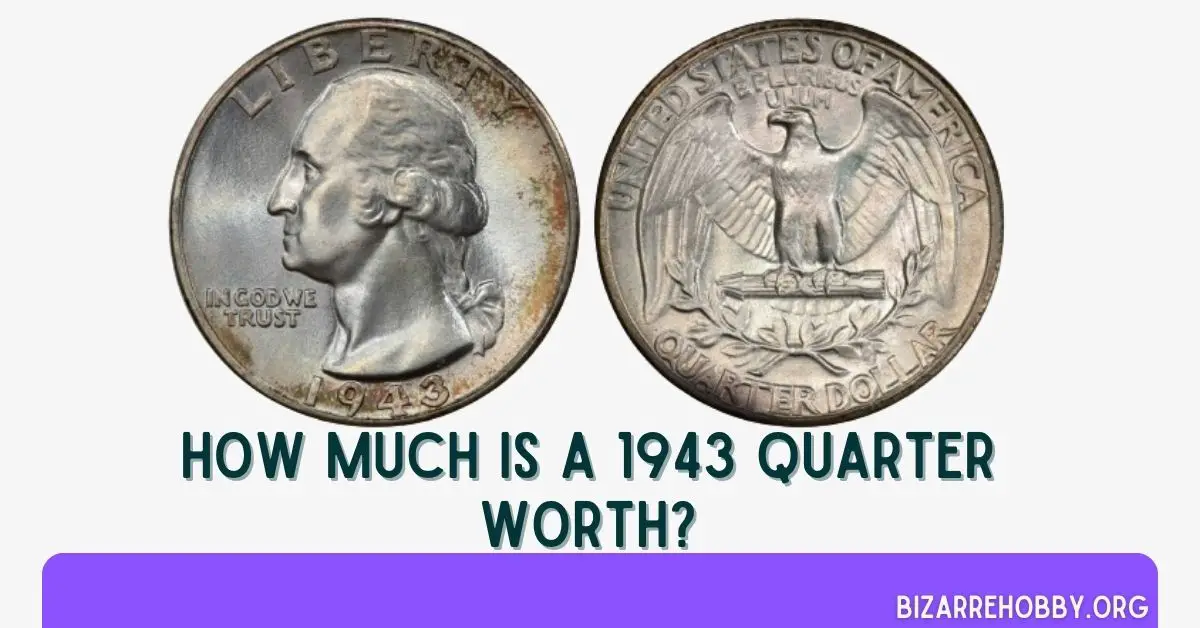The 1943 Silver Quarter is a cherished piece among coin collectors and history buffs. Minted during the tumultuous period of World War II, this coin carries significant historical value.
Part of the Washington Quarters series, which was produced from 1932 to 1988, the value of the 1943 Silver Quarter is influenced by its condition, grade, and rarity.
In this guide, we will delve into the value of the 1943 silver quarter, grading standards, and other essential information to help you make informed decisions when buying or selling this coin.
Value Chart for 1943 Silver Quarter
| Mint Mark | Good | Extremely Fine | MS-60 | MS-66 |
|---|---|---|---|---|
| 1943 No Mint Mark Silver Quarter Value | $5.50 | $5.50 | $10 | $85 |
| 1943 D Mint Mark Silver Quarter Value | $8.50 | $15 | $27.50 | $95 |
| 1943 S Mint Mark Silver Quarter Value | $8.50 | $12.50 | $25 | $110 |
Historical Significance of the 1943 Quarter
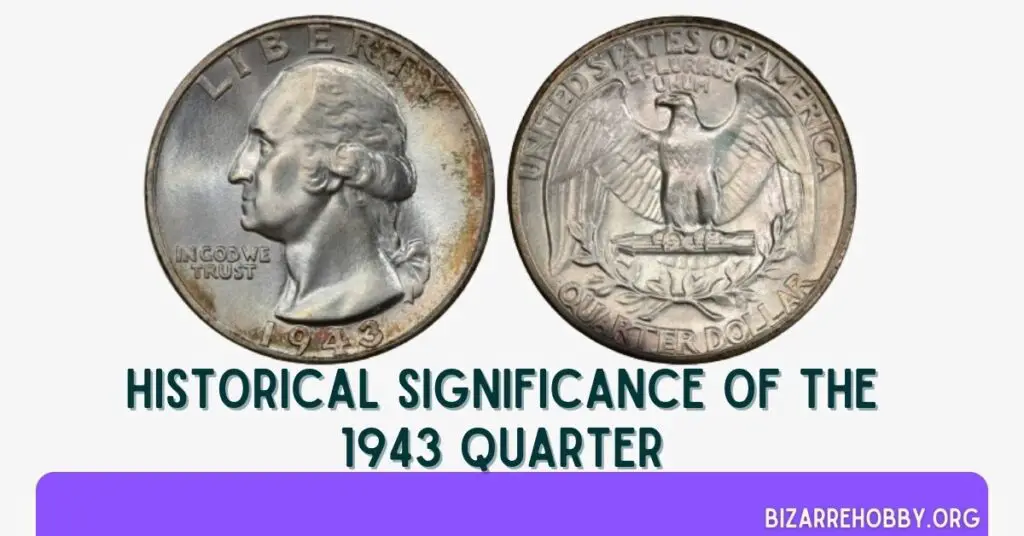
The 1943 Silver Quarter holds a unique place in American numismatic history. Minted during World War II, this coin reflects a period of significant global turmoil. The Washington Quarter series, which began in 1932 to commemorate George Washington’s 200th birthday, continued through the war years, including 1943.
The 1943 quarter is notable for being one of the last silver quarters produced before the U.S. Mint transitioned to base metals in 1965 due to rising silver prices and hoarding issues.
The 1943 Silver Quarter, with its rich history and intricate design, remains a valuable piece for collectors and history enthusiasts alike. Understanding its historical context, design elements, and technical specifications can help you appreciate its significance and determine its value accurately.
Design of the 1943 Silver Quarter
The design of the 1943 Silver Quarter is a testament to American heritage and artistry. Created by John Flanagan, the coin features iconic imagery that has become synonymous with American coinage.
Obverse Design of 1943 Silver Quarter
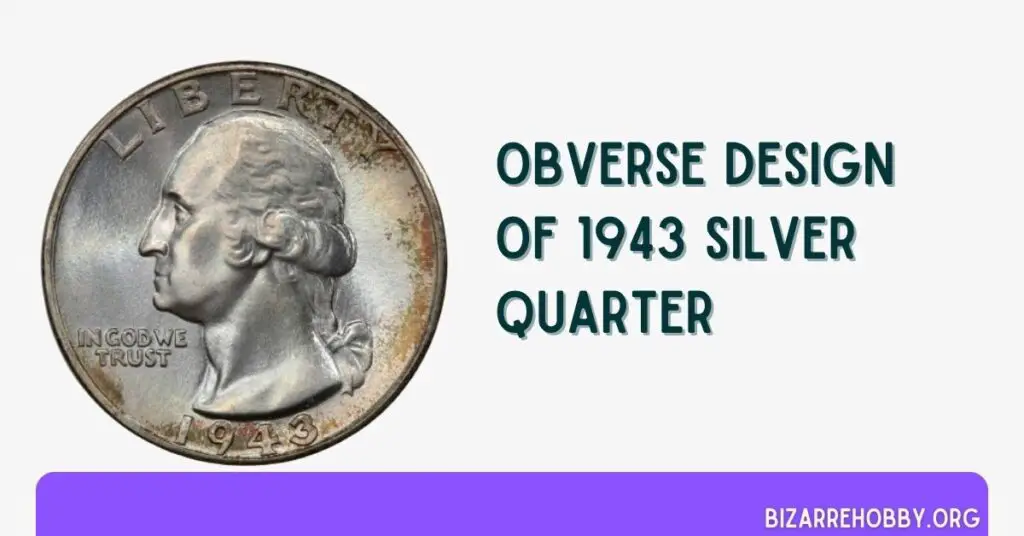
The obverse side of the 1943 quarter showcases a left-facing bust of George Washington. Above his head, the word “LIBERTY” is inscribed, symbolizing the nation’s core values. To the left of Washington’s throat, the motto “IN GOD WE TRUST” is prominently displayed. Below Washington’s image, the date “1943” is engraved, marking the year of minting. Flanagan’s initials, “JF,” are subtly incorporated into the neck truncation, honoring the designer.
Reverse Design of 1943 Silver Quarter
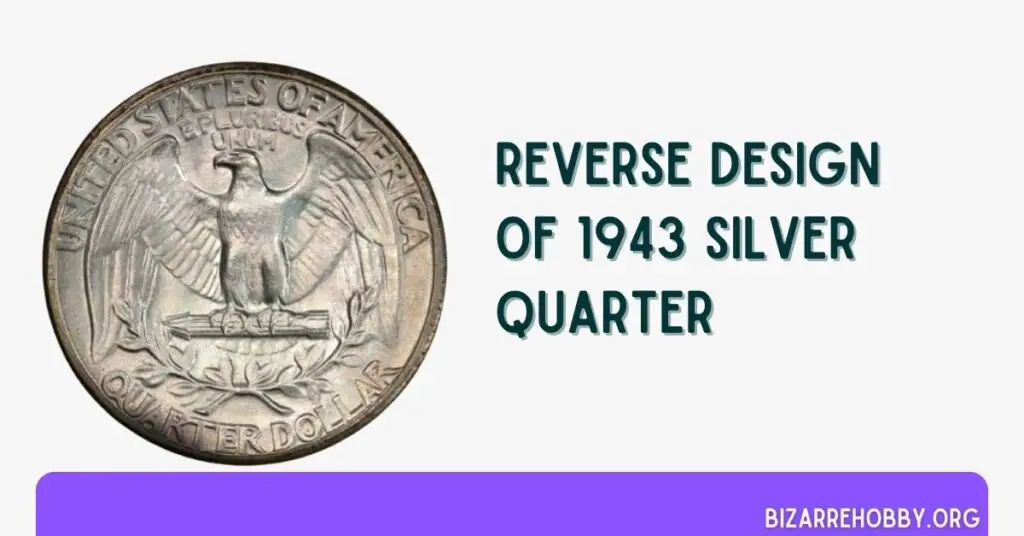
The reverse side of the 1943 quarter is equally significant. It features a heraldic eagle with outstretched wings, perched on a bundle of arrows, symbolizing the nation’s readiness for war. Below the eagle, two olive branches represent peace.
The inscriptions “UNITED STATES OF AMERICA” and “E PLURIBUS UNUM” (meaning “Out of many, one”) emphasize the unity and strength of the nation.
The denomination “QUARTER DOLLAR” is also inscribed on this side. For quarters minted in Denver and San Francisco, a small “D” or “S” mint mark is present under the olive branches.
Technical Specifications of 1943 Silver Quarter
| Face Value | 25 cents ($0.25) |
| Coin Thickness | 1.75 mm (0.06870 inches) |
| Coin Diameter | 24.3 mm (0.95669 inches) |
| Coin Weight | 6.25 g (0.2204 ounces) |
| Composition | 90% silver, 10% copper |
| Silver Weight | 5.623 g (0.1808 troy ounces) |
| Edge | Reeded |
| Shape | Round |
Grading Guide for 1943 Quarter
| Sheldon Scale | Grade |
|---|---|
| 1 | Basal State-1 |
| 2 | Fair |
| 3 | Very Fair |
| 4, 5, 6 | Good |
| 7, 8, 10 | Very Good |
| 12, 15 | Fine |
| 20, 30 | Very Fine |
| 40 | Extremely Fine |
| 50 | About Uncirculated |
| 60 | Mint State |
| 65 | Mint State |
| 70 | Mint State |
The 1943 Silver Quarter can be found in various conditions, ranging from heavily worn to pristine. The highest value is attributed to uncirculated coins.
Uncirculated coins exhibit no signs of wear from circulation. To determine this, inspect the coin for any wear on the cheeks. If the delicate luster is broken, the coin shows signs of wear.
Please refer to our grading guides to accurately determine your coin’s grade, which is crucial for assessing its value.
1943 Silver Quarter Value Guides
The US Mint issued three versions of the 1943 quarter: one without a mint mark, one with an “S” mint mark, and one with a “D” mint mark. When present, the “S” and “D” marks can be found on the reverse side of the coin.
1943 Silver No Mint Mark Quarter Value
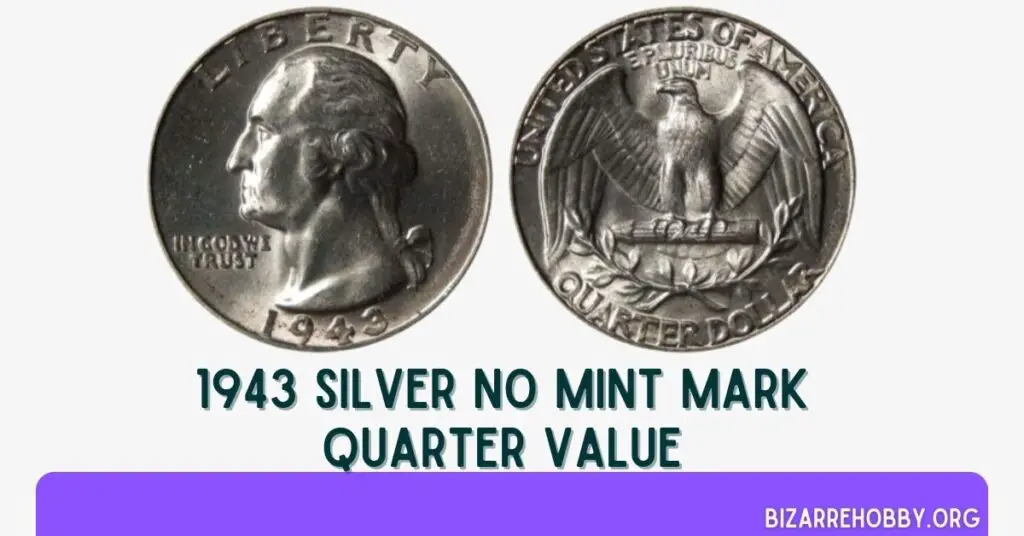
The Philadelphia Mint produced the 1943 Silver Quarter without a mint mark, with a mintage of 99,700,000.
Production of the 1943 Silver No Mint Mark Quarter ceased just before reaching the 100 million mark. Despite this, the coin is quite common, even in MS 66 and MS 67 grades. Many of these coins are found in MS 67 grades due to their exceptional toning.
However, due to the large mintage, wear and tear, along with production die issues, are common even in MS 67 grades. Therefore, when selecting these coins, it is important to consider both the grade and any potential issues with the specimen.
As previously mentioned, the value of the 1943 Silver Quarter depends on various factors, including grading. A quarter in good condition will have the lowest value due to significant wear and tear.
In good condition, only the major details are visible, with the rest flattened. The top letters may have begun merging with the rim. In this state, the coin’s value is primarily based on its silver content.
In fine condition, the coin shows less wear and tear than one in good condition. The hair and curls of George Washington may be flattened, but the hair on the forehead remains visible. The value of these coins is slightly higher than those in good condition, but still on the lower end.
Extremely fine condition coins exhibit minimal signs of wear. For this grade, the hair detail on George Washington’s head, cheeks, ear, and eye is crucial. If the details are crisp, the coin is classified as extremely fine.
The highest value is for uncirculated coins, which are described as untouched and completely fresh, as if directly from the mint. These coins are silver-white or have natural tones and show no signs of wear.
The value of a 1943 Silver No Mint Mark Quarter in circulated condition is at least equivalent to the silver content, approximately $5. The price remains similar in extremely fine condition. In uncirculated condition, an MS 60 grade coin is worth around $10.
The value increases to up to $85 for MS 66 grades but remains lower than many other coins in the Washington Series due to the large mintage, widespread circulation, and the coin’s relatively young age of about 80 years.
According to the NGC Price Guide, as of April 2024, a 1943 Washington Quarter can be valued between $5 to $85. However, in pristine, uncirculated condition, the value can soar up to $6,500 on the open market.
1943 Silver D Mint Mark Quarter Value
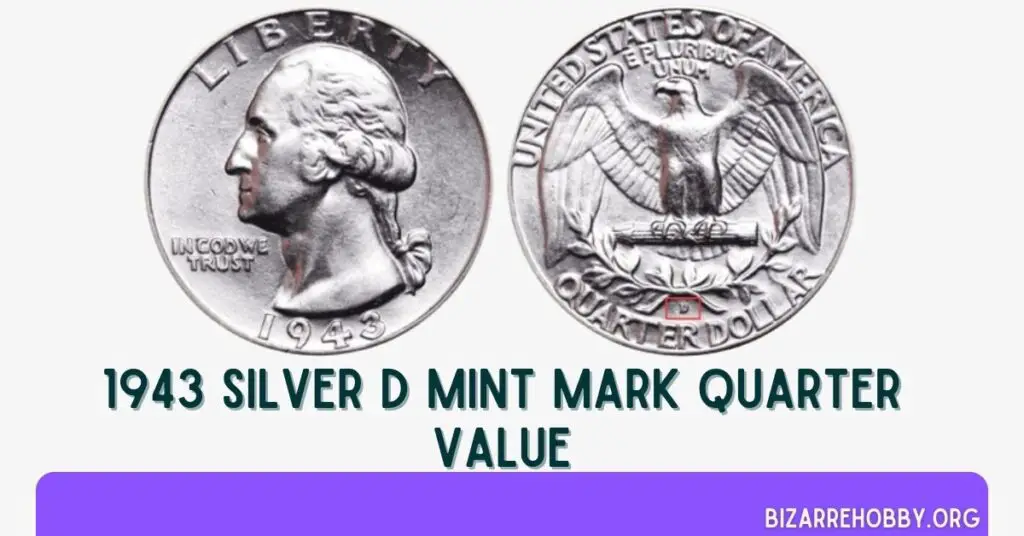
The 1943 Silver D Mint Mark Quarter shares the same specifications as the Philadelphia variety, including design, weight, diameter, fineness, composition, edges, and melt value. However, it has distinct differences.
This version was minted at the Denver Mint and features a small “D” mark on the bottom of the reverse side. The Denver Mint produced 16,095,600 of these quarters.
Unlike the Philadelphia Mint, the Denver Mint produced fewer coins, ensuring better quality control. The coins were struck from well-maintained dies.
Gem coins graded MS 67 are relatively common, and those graded MS 66 are even more abundant. In extremely fine condition, the 1943 Silver D Mint Mark Quarter is valued at around $15. In uncirculated condition, they are worth approximately $95.
According to the NGC Price Guide, the value of a 1943-D Quarter in circulated condition ranges between $8 to $25. On the open market, a pristine, uncirculated 1943-D Silver Quarter can fetch up to $9,500.
1943 Silver S Mint Mark Quarter Value
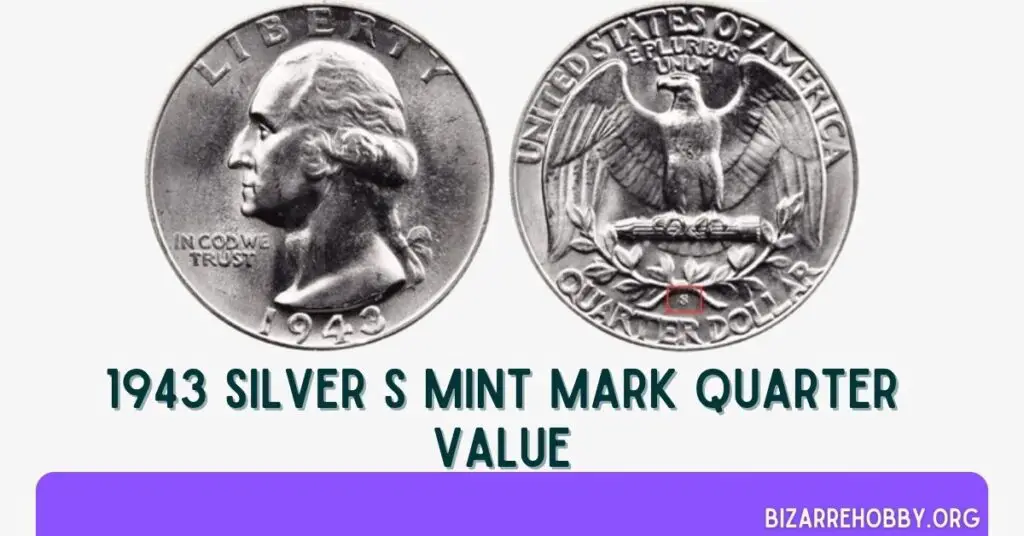
The 1943 Silver S Mint Mark Quarter, similar to its Denver counterpart, shares design, history, and structure with the Philadelphia variety. However, it features an “S” mint mark, a symmetrical Serif S, and was minted at the San Francisco Mint.
These quarters are slightly less rare than those minted in Denver. The San Francisco Mint produced 21,700,000 quarters in 1943, setting a record for its highest production of quarters until 1954, the year it ceased producing coins for circulation.
Mint State coins of the 1943-S variety are plentiful, with gems graded MS 66 and MS 67 readily available. Some semi-proof-like specimens exist due to repolishing worn dies to extend their useful life.
Repolishing has sometimes revealed raised lines on the struck coins, while in other cases, it has had minimal impact.
Several error coins have been recorded for this variety, including double-die coins, though only one prominent example has been noted so far.
In extremely fine circulated condition, the 1943 S quarter is valued at $12.50. In uncirculated condition, their worth can increase to $35, and uncirculated gems can sell for as much as $55.
According to the NGC Price Guide, the value of a 1943 Silver S Mint Mark Quarter in circulated condition ranges between $8.50 to $22.50. In pristine, uncirculated condition, these coins can sell for up to $10,000 on the open market.
Rare 1943 Silver Quarter Errors List
The 1943 Silver Quarters are not known for a wide range of errors compared to other Washington Quarters. However, the quantity of error coins is notable, making them rare and valuable despite their relative scarcity.
Several error coins have been recorded in auctions, fetching high prices.
1943 Silver Quarter Double Die Error

A double die error occurs when the coin’s markings overlap, and for the 1943 quarter, this error is found on the obverse side.
Notable instances of double die errors have been identified in the 1943 Silver Quarter, particularly from the Philadelphia and San Francisco mints.
- 1943 No Mint Mark Double Die Error: This coin is valued at around $2,750 in circulated and extremely fine condition. In uncirculated condition, its value can soar to $5,500, and for higher grades like MS 65, it can reach up to $12,000.
- 1943 S Quarter Double Die Error: Although not as valuable as the no mint mark version, this coin still holds significant value. In extremely fine condition, it is worth about $200. In uncirculated condition and MS 60 grade, the value doubles to $550, and for MS 65 grade, it can go up to $1,650.
1943 Silver Quarter Repunched Mintmark Error
Another notable error is the repunched mint mark error, which occurs when the mint mark die strikes the planchet twice. Several repunched mintmark error coins have been recorded for the 1943-S quarters.
Where to Sell Your 1943 Silver Quarter?
Knowing the value of your coins is one thing, but finding the right place to sell them is another. Here are some recommended sites to sell your 1943 Silver Quarter online, along with their pros and cons.
What to look for in the 1943 Silver Quarter?
When evaluating a 1943 Silver Quarter, several key factors can significantly impact its value. Here’s what you should focus on:
1. Mint Marks
The 1943 Silver Quarter was minted in three locations: Philadelphia (no mint mark), Denver (D mint mark), and San Francisco (S mint mark). The mint mark, if present, is located on the reverse side of the coin, below the eagle. Identifying the mint mark is crucial as it affects the coin’s rarity and value.
2. Condition and Grading
The condition of the coin is one of the most important factors in determining its value. Coins are graded on a scale from Poor (P-1) to Perfect Uncirculated (MS-70). Key areas to inspect include:
- Obverse Side: Look for wear on George Washington’s hair, cheeks, and the high points of the design.
- Reverse Side: Check the eagle’s feathers and the arrows it holds for signs of wear.
Uncirculated coins with no signs of wear are the most valuable. Coins with minimal wear are graded as Extremely Fine (EF) or About Uncirculated (AU).
3. Errors and Varieties
Error coins are highly sought after by collectors. For the 1943 Silver Quarter, notable errors include:
- Double Die Error: This occurs when the coin’s design is doubled, most commonly seen in the inscriptions “LIBERTY” and “IN GOD WE TRUST” on the obverse side.
- Repunched Mint Mark (RPM): This error happens when the mint mark is struck more than once, leading to a noticeable doubling of the mint mark.
4. Luster and Eye Appeal
The coin’s luster and overall eye appeal can also affect its value. Coins with a bright, original luster and no discoloration or spotting are more desirable. Look for coins with a frosty or satiny finish, which indicates minimal handling and excellent preservation.
5. Historical Context
Understanding the historical context of the 1943 Silver Quarter can add to its appeal. Minted during World War II, these coins are a tangible piece of history, reflecting the economic and social conditions of the time.
By carefully examining these factors, you can better assess the value of your 1943 Silver Quarter and make informed decisions when buying or selling.
FAQs on 1943 Silver Quarter Value
What is a 1943 silver quarter worth today?
The value of a 1943 quarter starts at around $5 and can go up to $110, depending on its grade, rarity, and condition. Rare coins can be worth hundreds or even thousands of dollars.
Is a 1943 quarter rare?
No, the 1943 quarter is not considered rare due to its high mintage of 137,495,600. However, coins in MS 68 condition can be rare. The rarity is determined by errors, condition, and grade.
Final Thoughts
The 1943 Silver Quarter is a fascinating piece of history, offering both numismatic and historical value. Whether you’re a seasoned collector or a curious enthusiast, understanding the various factors that influence the value of these coins, including mint marks, grading, and errors, is crucial.
By being well-informed, you can make better decisions when buying or selling these quarters. Remember, each coin tells a story, and the 1943 Silver Quarter is no exception, reflecting a unique period in American history.
